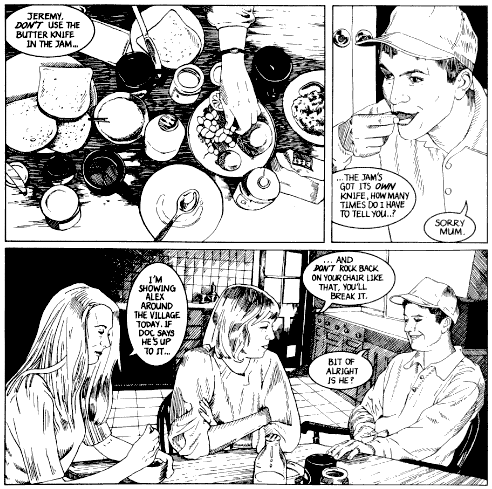StrangeHaven
 The semi-official “high concept” description of this series is “Twin Peaks in rural England”, and I think that captures it fairly well. But it’s Twin Peaks without the psychedelic surreality and forced, morbid weirdness to maintain the reputation for weirdness. And with charm. But maybe that’s covered by the “rural England” part of the description. I have fond memories of my cycling trip through the West Country (where StrangeHaven is located… somewhere), and the region does have a distinct charm to it.
The semi-official “high concept” description of this series is “Twin Peaks in rural England”, and I think that captures it fairly well. But it’s Twin Peaks without the psychedelic surreality and forced, morbid weirdness to maintain the reputation for weirdness. And with charm. But maybe that’s covered by the “rural England” part of the description. I have fond memories of my cycling trip through the West Country (where StrangeHaven is located… somewhere), and the region does have a distinct charm to it.
In any case, don’t get the impression that this is just an attempt to recreate that odd Northwest US town, but with cars driving on the other side of the road. Twin Peaks is just one influence. StrangeHaven has a personality all its own. A likeable one.
The focus of the story is Alex Hunter, a man who gets lost on his way to the coast and stumbles upon the town of StrangeHaven. The townspeople (some of whom have a hint or more of eccentricity about them) treat him well (especially one Janey Jones), and he rather likes the town. When he tries to leave, he gets lost again and ends up back in StrangeHaven. And decides to stay, rather than fight it.
 From there we continue to catch glimpses of the fascinating characters that populate this town. I could give one-line descriptions of some of them, but that wouldn’t properly capture the humanity and personality of them. Every encounter hints at some untold story about them, and leaves the reader wondering, “What happened to make Brian Dempsey so cranky?” “What’s the deal with this secret Mason-like order?” “What led this Brazilian shaman fellow to leave his people and come to Devon (and why does he look like an Anglo)?” “Is Adam really an alien or just crazy?” “And what about Naomi?”
From there we continue to catch glimpses of the fascinating characters that populate this town. I could give one-line descriptions of some of them, but that wouldn’t properly capture the humanity and personality of them. Every encounter hints at some untold story about them, and leaves the reader wondering, “What happened to make Brian Dempsey so cranky?” “What’s the deal with this secret Mason-like order?” “What led this Brazilian shaman fellow to leave his people and come to Devon (and why does he look like an Anglo)?” “Is Adam really an alien or just crazy?” “And what about Naomi?”
So far, Millidge is being coy. Very little has been revealed to answer these kinds of questions, but things are slowly unfolding… in ways that raise as many questions as they answer. Things may get disappointing when/if the mysteries are disclosed, but in the mean time, it’s a pleasure to suspend disbelief a bit and follow along.
As appealing as the characterisation is the art. The characters, the town, and just about everything else gives the distinct impression that it’s drawn from real life. The people all look consistently distinct, casino and the scenery looks authentic enough to give a genuine sense of place. The pages are laid out in the nine-panel-grid format, which helps ensure a high story-per-page ratio, but he breaks from that frequently for visual or story-telling effect.
 Millidge’s art has improved a bit since he started this series. One of the weaknesses of his snapshot style was that people’s faces sometimes seemed a bit flat and unface-like. Not that they were the wrong shape, necessarily, but that the hadn’t been translated into line art properly. (e.g. How do you draw an outline of a nose at that particular angle?) By #5 that’s no longer a significant problem, as his modeling skills have improved.
Millidge’s art has improved a bit since he started this series. One of the weaknesses of his snapshot style was that people’s faces sometimes seemed a bit flat and unface-like. Not that they were the wrong shape, necessarily, but that the hadn’t been translated into line art properly. (e.g. How do you draw an outline of a nose at that particular angle?) By #5 that’s no longer a significant problem, as his modeling skills have improved.
He also experiments a bit, switching from his primary artistic style to another briefly, for effect. When the shaman character recounts the tribal creation myths, they are presented in monochrome paints instead of pencil and ink. He’ll throw a photographic panel in here and there, which actually makes the surrounding panels seem more authentic by implying that there are photographs behind every panel.
StrangeHaven (the series) is a bit like StrangeHaven (the town). I wandered into it, and now I just don’t want to leave.
